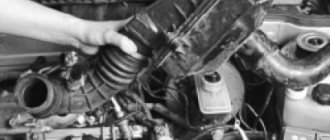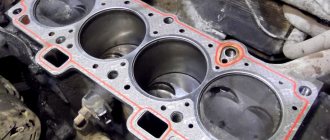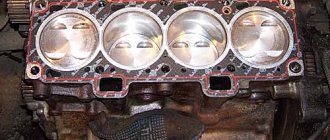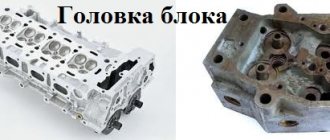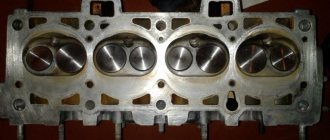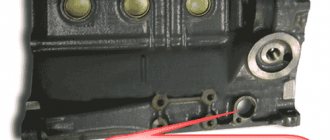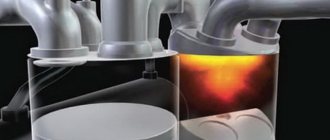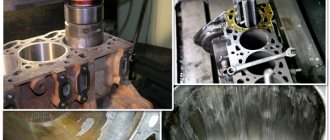Is it possible to drive with a broken cylinder head gasket?
Car owners often ask whether it is possible to drive with a broken cylinder head gasket. It is not always possible to immediately fix the problem, for example, when the malfunction occurs on the road or far from a service station.
Experts say that it is impossible to travel in such a situation. This is especially true if antifreeze gets into the oil or vice versa. The only way out is to move only in tow. If you ignore this requirement and drive even 200-300 km, the engine may need to be overhauled.
In a situation where oil and antifreeze do not mix, driving a short distance is allowed. Here we are talking about minor damage, but it is necessary to monitor the engine temperature and coolant level. After all, if the gasket is punctured from the inside, then there is a high risk of damage to the valves and pistons as a result of antifreeze getting into the cylinders.
VAZ 2109 with a broken cylinder head gasket - how to determine
Well, we are at the most ordinary “nine”. Let's start identifying the signs of this malfunction.
We'll start by inspecting the expansion tank. There is noticeable steam that shouldn't be there. You can see it in the photo. This just means that the cylinder head gasket is broken. The engine temperature is 20-30 degrees, that is, it has just been started. At higher temperatures, the liquid in the tank will “boil” and “ask” to come out.
These will be smoky clouds from the exhaust system of a car with a broken cylinder head gasket.
Now let's turn off the engine and look at the outlet of the exhaust system - it has a thick edging. Below, too, you will definitely find a sweetish-tasting liquid. You can taste the “sweetness” and, by placing your palm under the exhaust outlet while the engine is running, the smell and smoky fumes will remain on it.
When using an engine for a long time with a broken cylinder head gasket, you may notice emulsification of the engine oil. Scoop up a little with a screwdriver and you will see a pure emulsion - a mixture of oil and coolant.
Also, the coolant cannot help but touch the spark plugs. It definitely gets into the cylinder, washing not only the piston and valve, but also affecting the spark plugs. In the photo below you see VAZ 2109 spark plugs, the left spark plug has a reddish tint. We turned off the engine while it was hot, meaning the spark plug had time to dry out. But you can still see that she is different from the other. If you turn off the car and immediately pull out the spark plug, it will still be wet.
So, under the head of this car we see 4 pistons, 2 of which are washed, and 2 are quite normal. Here are the washed pistons - this is another sign of a broken cylinder head gasket. In this case, it is not pierced in a completely standard way; usually the piercing occurs at the edge, after which the heated antifreeze or antifreeze enters the cylinder.
Let's summarize? So, the obvious signs of a broken cylinder head gasket:
- steam from the expansion tank;
- clouds of smoke from the exhaust system;
- fat system output and liquid at the bottom;
- emulsification of motor oil;
- candles with a red coating;
- washed pistons.
Now let's see what overheating of the head leads to.
Signs of a broken cylinder head gasket
The main difficulty for novice car owners is to promptly detect damage to the cylinder head gasket. Almost all cars are in the “risk zone”, but most often the problem is faced by owners of Niva Chevrolet, VAZ 2106, 2109, 2110, 2112, 2115, 2114, 2107, BMW E39, Opel Astra, ZMZ 406, Daewoo Lanos and Kalina. This is an incomplete list of cars in which the cylinder head gasket periodically fails (burns out). Symptoms of a malfunction may differ depending on which area is broken.
Damage to the cylinder head gasket between the cylinders
In VAZ cars and a number of other models, the gasket very often burns out between the second and third cylinders.
The easiest way to recognize a malfunction is by the following signs:
- Uneven operation of the engine during operation of which you will feel a missing spark plug due to coolant or oil getting into it. As a result, the internal combustion engine will triple.
- Reducing engine compression. Damage to the cylinder head gasket leads to exhaust gas leaking from the cylinder block during the piston stroke, causing compression in the problem area to drop or decrease to minimum values.
- Addition to clause 2. At the moment when a compression stroke occurs in one cylinder, and a power stroke occurs in the adjacent one, when the gasket is broken, the exhaust gases, in our case, of the second cylinder are mixed with the air-fuel mixture of the first. This will lead to problematic starting of the engine, but after warming up the latter operates stably.
To diagnose the problem, it is enough to remove the caps of the high-voltage wires from the spark plugs one by one and pay attention to changes in the operation of the engine.
If no changes occur when removing a cap, this may indicate damage to the cylinder head gasket in this area. Also check the compression in the engine cylinders.
Damage to the cylinder head gasket between the cylinder and the cooling system
Sometimes the problem occurs between the cylinder and the cooling channel. In this case, the malfunction can be recognized by the following symptoms:
- Uneven operation of the power unit (as in the previous case). A cylinder spark plug that gets antifreeze on it will not work.
- Reduced coolant level. This factor is explained by coolant leakage due to a violation of the integrity of the gasket.
- Formation of steam or air bubbles inside the expansion tank. It is better to carry out diagnostics on a cold internal combustion engine, because when checking “hot”, the cause of the problem may be poor-quality coolant. The problem occurs due to exhaust gases entering the cooling system. For diagnostics, you can put a rubber glove or a condom on the outlet of the expansion tank. We will dwell on this issue below.
- The appearance of thick white smoke from the exhaust system. Appears due to active vaporization. This is facilitated by the combustion of antifreeze in the combustion chamber and subsequent removal through the exhaust pipe.
- The presence of a kind of “emulsion” in the expansion barrel. Car owners often call it “mayonnaise” or “sour cream” because of its characteristic yellowish color. The reason is the mixing of antifreeze and oil. The problem can be identified by looking into the tank or removing the oil level dipstick from the engine.
Other signs
There are a number of other signs that can be used to draw conclusions about a damaged cylinder head gasket.
Let's briefly look at their features:
- Exhaust gases exit from under the cylinder head. The symptom appears when there is damage between the cylinder and the outer part of the cylinder head. This is because gases find their way through the damaged area of the gasket. If the gasket burns out significantly, loud sounds uncharacteristic of engine operation will be heard.
- The appearance of oil at the junction of the head and cylinder block. If the integrity of the gasket is damaged, it allows lubricant to leak out and contaminate the outside of the engine.
- Problems with the stove. Due to disturbances in the cooling system, difficulties arise in warming up the interior. Gases from burnt fuel enter the “corridors” of the cooling system. As a result, air reaches the heater heat exchanger, which works worse.
- Soot or moisture on spark plugs. To diagnose, unscrew the spark plugs one by one and look at their condition. The appearance of oil or antifreeze on the contacts, as well as carbon deposits, often indicates a violation of the integrity of the cylinder head gasket.
- Increase in oil level. This occurs due to antifreeze entering the lubrication system.
- Engine overheating. Damage to the cooling and lubrication system impairs heat dissipation, and the engine quickly gains temperature.
- Release of coolant from the exhaust system. Antifreeze droplets fly into the air, which are easy to diagnose.
- Deterioration of internal combustion engine characteristics. Indirect signs of a malfunction include an increase in the “gluttony” of the motor, a decrease in power, etc.
- Increased pressure inside the cooling system pipes. A hole in the gasket where the coolant passes through will result in exhaust gases entering the cooling system pipes. The latter, due to the creation of increased pressure in them, will be very hard (like stone) to the touch.
Please note that it is necessary to analyze the malfunction as a whole. For example, the appearance of carbon deposits on spark plugs or problems with the stove may indicate other malfunctions of the machine.
The difference between a blown and blown cylinder head gasket
A burnout should be understood as a malfunction in which exhaust gases break into adjacent cylinders, oil channels or the cooling jacket of the internal combustion engine. Most often, burnout occurs between the cylinders, since the seal in this place takes the greatest thermal load.
The concept of breakdown is more extensive and also includes cases when the oil and coolant circulation channels communicate with each other. Due to mixing in the expansion tank and/or pan, a coffee-colored emulsion is formed. If there is a breakdown outside, the first sign will be traces of oil/antifreeze on the engine.
Signs of burnout
- The engine is running rough, power loss, black smoke from the exhaust pipe (unburned fuel). Communication between adjacent cylinders leads to disruption of gas exchange. During the compression stroke, gases flow into the adjacent cylinder, as a result of which sufficient pressure is not created at the end of the compression stroke, combustion of the mixture is disrupted or there is no combustion at all. Because of this, the engine runs unstably and strong vibrations are transmitted to the body.
- Increased pressure in the engine cooling system. As the system is filled with exhaust gases, all rubber pipes will be swollen, which can be checked by touch. Often the consequence of a broken gasket is an antifreeze leak. Due to increased pressure in the system, leaks occur in the most weakened areas: places where pipes are compressed with clamps, loose connections to fittings, rubber hoses cracked due to age.
If your car has regular problems with coolant leakage, focus on finding the cause rather than constantly eliminating the consequences of the malfunction.
- Oily spots on the surface of the antifreeze in the expansion tank. The reason is unburnt gasoline and oil impurities that seep into the coolant along with gases.
- The engine gets very hot. Hot exhaust gases heat up the antifreeze, so the cooling system cannot cope with heat removal.
- White smoke from the exhaust pipe. The reason is a burnt-out gasket between the coolant circulation channel and the cylinder, which causes antifreeze to enter the combustion chamber. Often the problem begins to manifest itself after a long period of inactivity, when antifreeze accumulates in the cylinder. On top of that, in such a situation you will notice difficulty starting the engine. Naturally, in this case, the level of antifreeze in the tank will constantly decrease.
You should not delay repairing the burnout, since the accumulation of a large amount of antifreeze in the combustion chamber can lead to water hammer and, as a result, expensive major repairs.
Why can a cylinder head gasket blow through, how to determine it and what to do
A breakdown that occurs in the cylinder head gasket, or simply the cylinder head, does not lead to anything good. This is an unpleasant phenomenon for any car owner.
Damage to this element immediately negatively affects the operation of the heating system, the engine overheats, smoke begins to pour out from under the hood, and an emulsion appears in the engine oil.
If a motorist encounters at least one of these signs, the first thing to do is check the condition of the cylinder head gasket or seal.
There are various causes and signs of a broken gasket that require appropriate action on the part of the vehicle owner. The motorist can learn to determine the presence of problems in this unit. He must also know how to act in such a situation.
Signs that the cylinder head gasket has blown
The purpose of the cylinder head gasket is to ensure tightness and prevent gases from penetrating from the cylinders back up into the engine compartment, as well as mixing coolant, engine oil and fuel with each other. In a situation where the cylinder head gasket is punctured, the seal of the block is compromised. The following signs will tell the car owner about this:
Why does the cylinder head gasket break?
In most cases, the reason why problems arise with the cylinder head gasket is simple overheating . Because of it, the block cover may “lead”, and the plane along which the gasket adheres to two contacting surfaces will be disrupted. As a result, depressurization of the internal cavity occurs with all the ensuing consequences. It is mainly aluminum heads that change their geometry. Cast iron is not subject to such malfunctions; they are more likely to crack than to bend, and only in the most extreme cases.
Scheme for pulling cylinder head bolts on VAZ “classics”
Also, due to overheating, the gasket can heat up to temperatures at which it changes its geometry. Naturally, in this case depressurization will also occur. This is especially true for iron-asbestos gaskets.
Another reason is a violation of the bolt tightening torque . Both very large and small torque values have a detrimental effect. In the first case, the gasket may collapse, especially if it is made of low-quality materials. And in the second, exhaust gases pass out without obstructing them. In this case, gases together with atmospheric air will have a detrimental effect on the gasket material, gradually destroying it. Ideally, the bolts should be tightened using a dynamometer that shows the torque value; in addition, the sequence of their tightening should be observed. Help information about this can be found in the manual.
As a rule, the tightening sequence is to tighten the central bolts first, and then the rest diagonally. In this case, twisting occurs in stages. In particular, in VAZ cars of “classic” models, the torque step is 3 kgf. That is, all bolts in the specified sequence are tightened to 3 kgf, after that they are tightened to 6 kgf, and to 9.10 kgf.
Signs of engine overheating
When diagnosing a breakdown, it is important to correctly determine the fact of engine overheating.
There are several main features here:
- Sharply rising coolant temperature according to the indicator in the cabin.
- The appearance of condensation on the surface of the unit.
- Steam from under the hood.
- Reduced power.
- Noisy and rough operation of the internal combustion engine, detonation, and will not start.
- White deposits on the spark plug electrodes.
Operation of the machine in case of overheating of the internal combustion engine is prohibited, because this is fraught with its wedge and the need for major repairs.
Thermostat
The cause of overheating of the coolant may also be the thermostat - this part in the cooling system is required to maintain a stable temperature.
When the engine is still cold, all the antifreeze circulates in a small circle, bypassing the radiator, so the engine warm-up time with a closed thermostat is significantly reduced.
When the required temperature is reached, the valve of the thermostatic device is activated (opens), and the antifreeze passes in a large circle through all the pipes of the cooling system and the radiator.
This cools the engine.
If the thermostat does not open in time, boiling of the antifreeze is inevitable; the liquid will not cool to the required limit without passing through the radiator.
In any case, you need to carefully monitor the devices and prevent overheating.
How to make sure the thermostat is working properly?
First of all, you should make sure that all large radiator pipes (upper and lower) are heated evenly.
If some of them remain cold after warming up, check the functionality of the thermostat.
To check the temperature control device, it must be removed from the vehicle. Removing the thermostat is not difficult, so let’s focus on diagnostics.
To check you will need any utensils, an electric heater and a thermometer.
We pour water into the container, place the part and water in it and look at the thermometer when the thermoelement begins to open.
The temperature range at which the valve should operate is indicated for each thermostat and depends on the specific car model.
Signs of a blown head gasket
A car engine is a rather complex device, and even specialists are not always immediately able to accurately diagnose it.
But there are some signs, and if they are present, then the head gasket is still burnt out:
- antifreeze (antifreeze) is periodically thrown out of the expansion tank;
- the engine is running rough, there is no compression (or it is very low) in one or two cylinders;
- the stove in the car blows cold air;
- the engine quickly overheats, and the sensor on the instrument cluster shows a high temperature;
- oil appears in the cooling system, and coolant appears in the engine crankcase, which can be determined in two ways (1. drops are visible on the engine oil level dipstick; 2. yellow foam forms on the oil filler cap)
While many car enthusiasts can replace a thermostat or expansion tank cap, replacing the head gasket is much more difficult.
Especially when the engine model is complex and “stuffed” with various electronic devices.
Burnout of the gasket between two adjacent combustion chambers
Burnt gasket between cylinders 2 and 3. As expected, since the compression in them has dropped.
Separately, it is worth noting the case when the gasket burns out between two adjacent combustion chambers. There are no obvious visual signs of such a burnout.
But there are symptoms that indicate a burnout of this nature - a decrease in engine power, high fuel consumption, difficult starting with fully functional ignition and power systems and an adjusted gas distribution mechanism.
Diagnostics
We diagnose such a malfunction simply - we measure the compression level in all cylinders.
Compression measurement
In the event of a gasket breakdown, the compression in two adjacent cylinders will be an order of magnitude lower than nominal, which indicates a breakdown.
In this case, when replacing the gasket, you should carefully examine the burnout location; perhaps a hole or microcrack has appeared there, and it will continue to cause gasket burnout in this very place.
Symptoms of a burnt cylinder head gasket
Most drivers do not know how to check whether the cylinder head gasket is blown. It's actually quite simple. The following symptoms indicate a failure of the cylinder head seal:
Important note: the first four symptoms are the same when cracks appear in the cylinder head or block. It is possible to determine what actually happened only after removing the head from the engine, which is inevitable when replacing the gasket.
Knocks out coolant
Problems with coolant, without signs of leakage from the system, are clear signs of a violation of the integrity of the gasket. When the gasket between the combustion chamber and the coolant channel burns out, high-pressure gases break into the cooling system, create excess pressure and squeeze the coolant through the expansion tank plug.
If the tank cap is tightened tightly, as it should be, and the safety valve in it is faulty, the rubber pipes of the cooling system may burst due to excess pressure, or the burnout area will expand, with gases escaping into the oil channels. More often the latter option happens.
How to find out if the cylinder head gasket is blown
The greatest difficulty for many car owners is to determine that the cylinder head gasket is the cause of the problem.
To check, follow these steps:
- Start the engine and inspect it. Pay attention to the presence of smoke from the gap between the head and the cylinder block itself. During operation there should be no ringing or other suspicious noises that have not previously been observed.
- Inspect the expansion tank of the cooling system, the container for filling the lubricant and the radiator cap for the appearance of a reddish emulsion. If the lubricant gets into the antifreeze, traces of the emulsion can be seen on the cap of the expansion tank and radiator tank.
- Check compression in different cylinders. Its sharp decrease may indicate a broken gasket; also read why different compression occurs in the cylinders.
- Start the engine, let it run and look at the condition of the exhaust gases. The appearance of thick white smoke often indicates damage to the element in question. Pay attention to the smell of smoke. If you use antifreeze in the cooling system, it will be slightly sweet.
- Check the fluid level in the expansion tank. Its decrease indicates a problem.
- Measure the engine oil level. If antifreeze gets into the lubrication system, you may notice a rise in the level above the MAX mark.
- Open the radiator/expansion tank cap and check the coolant for gas emissions. For diagnostics, you can use a rubber glove or bag (we will discuss this in detail later).
Additionally, pay attention to the signs of a broken gasket, which were mentioned at the beginning of the article.
How to find out about a broken cylinder head gasket? Signs
The cylinder head gasket is designed to provide a seal. The task of the part is to eliminate the possibility of gases entering the power unit compartment. It is also designed to prevent mixing of fuel, lubricants and coolant. Let's take a closer look at the signs of a malfunction:
- the appearance of exhaust from under the block. Anyone can identify this sign, because exhaust gases will appear directly from under the hood. All this will be accompanied by a characteristic smell and loud sounds. But in practice this does not always happen. Sometimes the burnout of the consumable element is minimal and the release of exhaust gases is almost unnoticeable;
- lumbago. In this case, a situation will arise that resembles the “triplication” of the power unit. This is due to the fact that exhaust gases will mix with the combustible mixture in the cylinders. Usually in such cases there are difficulties in starting the power unit, but after a while the engine begins to work quite properly. You can diagnose the problem using a compression test. In cases where the fuel mixture is mixed with exhaust gases, the cylinders will have different compression values;
- coolant entering the cylinder. This problem occurs as a result of damage to the gasket between the combustion chamber and the cooling jacket. The problem will be indicated by the appearance of white smoke. The car owner may also notice a drop in the coolant level in the tank;
- exhaust entering the coolant. In such a situation, exhaust gases may enter the coolant system directly from the cylinder block. To identify the problem, you need to open the coolant tank or radiator cap. If there are exhaust gases in the system, the liquid will boil. A little later we will dwell on diagnostic methods;
- lubricant leak. As a result of a burnt-out cylinder head gasket, oil leakage is possible, and the problem can be identified through a visual inspection. Lubricant leaks will be located directly on the cylinder block;
- mixing coolant and oil. As a result of damage to the consumable, antifreeze may end up in the power unit compartment. This will have an extremely negative impact on the operation of the engine, since the action of antifreeze reduces the performance characteristics of the oil. The engine will have to work under extreme load conditions, which will lead to increased wear. The driver needs to pay attention to the coolant expansion tank. Oily spots in the tank will indicate a problem. It is necessary to open the tank lid and look at the surface of the lid. If an oily liquid resembling mayonnaise forms on it, this means that the oil has been mixed with the coolant. The same problem will be indicated by the formation of a reddish emulsion on the dipstick used to check the oil level;
- rapid engine overheating. Usually the problem is caused by exhaust gases entering the coolant. As a result, the system does not have time to cool the engine. In such a situation, it is necessary not only to replace the gasket of the main cylinder block, but also to thoroughly flush the cooling system;
- high pressure in the radiator. Since depressurization occurs as a result of gasket burnout, exhaust gases are directed into the coolant system through the pipes. Therefore, these elements become very hard. It is easy to diagnose by touch;
- deterioration of the stove. As a result of a seal failure, exhaust gases enter the cooling system. In such a situation, a decrease in the efficiency of heating equipment is due to airing of the heat exchanger. In this case, the coolant temperature is constantly changing;
- wet spark plugs. Carbon deposits may form on them as a result of contact with coolant.
The appearance of carbon deposits on the spark plugs
If the power unit overheats, condensation forms on the surface. This will indicate damage to the gasket or the appearance of cracks directly in the block. In this case, it is recommended to contact a specialized service and conduct computer diagnostics. It is possible that the problems are related to the ignition system.
It is necessary to mention once again about mixing lubricants with coolant. The result is a yellow mixture.
If such a problem occurs, the car owner cannot do without just replacing the gasket. You will need to thoroughly flush the system, including all channels. It is extremely difficult to do such work on your own. Therefore, most often they turn to service stations. The service will cost a fairly large sum, comparable to the repair of a power unit.
Video on the topic
1200 rub. for the photo report
We pay for photo reports on car repairs. Earnings from 10,000 rubles/month.
Write:
A breakdown of the cylinder head gasket leads to such unpleasant consequences as engine overheating, poor operation of the stove, the appearance of exhaust gases from under the hood of the car, the appearance of an emulsion in the engine oil, the appearance of white smoke from the exhaust pipe and some others. If the above symptoms or one of them appear, you need to check the cylinder head gasket. There are several ways to do this. Next, we will look at why the cylinder head gasket breaks, what consequences this leads to, and what to do if this trouble happens to your car’s engine.
Symptoms, causes and signs of a blown cylinder head gasket (cylinder head)
There are a number of “classic” breakdowns that affect cars of all makes and ages. One of these breakdowns is when the cylinder head gasket burns out. The breakdown is unpleasant and requires immediate repair.
The cylinder block gasket ensures the tightness of the combustion chamber, oil channels and cooling jacket at the junction of the cylinder block with the head. Failure of the gasket leads to a violation of the tightness, followed by failure of the internal combustion engine.
Most often, burnout occurs between one of the cylinders and the water jacket, spreading further along the plane. But there are other options, for example, between the oil channel and the cooling channel.
Why does the cylinder head gasket break?
Car owners often ask why the cylinder head gasket fails and gets damaged. Let's highlight the main reasons.
Overheat
Most often, the cylinder head gasket burns out due to engine overheating, so it is important to identify the problem at an early stage and fix it. Due to changes in temperature conditions, the block cover “moves away” and the contact between parts of the motor deteriorates. The result is a lack of tightness of the power unit with consequences for the gasket.
As a rule, aluminum cylinder heads are susceptible to this problem. The cast iron head (installed on diesel engines) is more resistant to temperature changes. But it may become deformed or damaged.
The effect of temperature often leads to deformation of the gasket itself, which breaks the tightness of the system.
Incorrect torque when tightening cylinder head bolts
When assembling the engine, it is important to know the exact tightening torque of the bolts holding the head to the cylinder block. Increasing or decreasing this parameter can lead to destruction or deterioration of tightness, respectively.
In the second case, the cylinder head and cylinder head do not fit tightly to each other, which is why gases with atmospheric air pass into the existing holes and destroy the gasket.
To avoid such consequences, it is necessary to tighten the bolts using a dynamometer and strictly follow the manufacturer's instructions.
An equally important point is compliance with the screwing sequence. Detailed information on how to perform the work is given in the instructions for the car.
For example, the VAZ uses the following rules:
- First, the central bolts are screwed in, and then diagonally.
- The force is 3 kg*s, and then they reach 6 kg*s and 9-10 kg*s.
In 8 out of 10 cases, the cause of a broken gasket is non-compliance with the broaching rules in matters of torque, sequence and other nuances.
Therefore, be sure to read about the correct tightening of the cylinder head and with what force this should be done.
Low quality material
When purchasing pads, choose products from trusted stores.
Products come in the following types:
- Multilayer steel. Contain from two to five layers. The surface is treated with silicone for channel edging.
- Composite. Old technology that is almost never used. The base is asbestos and graphite, and the piston part is surrounded by steel rings.
- Copper. They are characterized by a high degree of reliability and are used on some types of cars.
- Elastomeric. Made of steel with a plastic material applied to the surface. There are steel rings at the gas joints, and the passages are edged with sealant.
- Non-asbestos. Manufactured using more modern materials.
The cost of a cylinder head gasket is not too high, so it is not recommended to save much on this, since such savings can be costly later.
Places where cylinder head gaskets burn out
Additional reasons
There are a number of additional factors why the gasket may burn out:
- Natural aging.
- Violation of the fuel combustion process. Most often, problems arise in the head, where cracks occur. The cylinder head, as a rule, has an aluminum base. When heated, rapid expansion occurs and the head presses on the gasket. The latter cannot withstand and is damaged.
- Increased temperature in the combustion chamber due to incorrect ignition angle, etc.
The car owner must understand the difference between a “breakdown” and a “burnout.” In the first case, there is serious damage to the gasket or its elements, and in the second, minor damage to integrity occurs, which sometimes cannot be found on the surface.
Why does the cylinder head gasket burn out?
Most often, the cause of a burnt-out seal is overheating of the engine, due to which the cylinder head plane is deformed. 6-cylinder in-line engines are most sensitive to such deformation due to thermal expansion.
A disruption of the combustion process in the cylinder (detonation and/or glow ignition) also leads to breakdown. With glow ignition, the mixture is ignited not by a spark, but by the overheated part of the spark plug. Occurs when incorrectly selected candles. During detonation combustion, the mixture ignites until a spark occurs at the electrode. Main causes of detonation:
- Mismatch between the octane number of gasoline and the compression ratio of the engine. Such a general definition includes both cases when the octane indicator declared at a gas station does not correspond to reality, as well as an unaccounted increase in the compression ratio after repairs or due to the formation of carbon deposits in the cylinders.
- Mixture too lean.
Knock combustion is characterized by an ultra-high flame front propagation speed, which places the combustion chamber walls under extreme thermal and mechanical stress.
The gasket can burn out not only due to increased temperature, but also due to the additional pulling force that acts on the bolts. It occurs due to increased pressure in the combustion chamber until the piston overcomes top dead center (TDC).
Video: Broken cylinder head gasket signs and consequences
Which cylinder head gasket to choose
If the engine specification specifies a metal gasket, then that is what should be used. It will be most reliable to use an original spare part, but if you experiment, then for the better.
Many manufacturers produce products of even higher quality, not being limited by the peculiarities of mass production of cars. Their brands are easy to find through online reviews.
Usually they are also factory suppliers, but the goods are supplied according to their own catalog numbers. A list of analogues is available in the catalogs of major suppliers.
Risk of serious engine damage due to cylinder head gasket
The greatest danger with unpredictable consequences awaits the car owner in the case where the damage to this seal is significant. Through the channel formed in this place, a large amount of antifreeze begins to flow into the cylinder, which sooner or later accumulates in the combustion chamber, and then when there is a large accumulation of liquid in the cylinder, a hydraulic shock occurs. The piston, making reciprocating movements, “bumps” into a layer of liquid located above it, which, as everyone knows, is incompressible, so a water hammer occurs, or as wits romantically called it, “the fist of friendship.”
In this case, the consequences can be the most fatal and costly engine overhauls (at best) cannot be avoided. And in the worst case scenario, if the connecting rod breaks through the wall of the engine block, then this engine can be taken straight to the scrapyard. Damage that is typical for water hammer is: - bending of the connecting rod, destruction of the piston, breakage of the connecting rod, damage to the cylinder head, crankshaft or crankcase.
In addition to all this, such an antifreeze leak can lead not only to cooling problems, specifically worsening its efficiency, but can also lead to engine oil getting into the coolant circulation channels, thereby clogging small channels designed for less thick technical fluid. If you ignore this breakdown, the engine may soon overheat.
In some cases, exhaust gases may make their way into the cooling system due to the cylinder head gasket not being tight. This is also an extremely dangerous “bell” for drivers and can be diagnosed visually by the appearance of exhaust gas bubbles in the expansion tank. In this case, the engine temperature itself will quickly go into the red zone during operation, which can cause rapid overheating of the power unit.
And finally, one more important point that will tell you about the malfunction. Exhaust gases may escape into the engine compartment. The smell, noise when the engine is running, as well as exhaust gases under the hood - this is what you will see in this case.
In general, with this malfunction, a general loss of engine power will be noticeable, a decrease in its thrust and unstable operation, as well as low compression.
Checking for microcracks
When checking the cylinder head gasket, it is important to pay attention to the presence of cracks. Several methods are used here.
Magnetic particle testing
The action algorithm is as follows:
- Place magnets on all sides of the head.
- Place metal shavings on top of the cylinder head.
- Pay attention to the "drawing". The chips will be drawn to the magnets, but they will remain in places of depressions and damage.
Using liquid
To check, do the following:
- Prepare the colored liquid using kerosene, acetone or another solvent.
- Apply the composition.
- Wait five to ten minutes.
- Remove excess liquid.
If there are defects, they are easy to notice even without a detailed inspection.
Pressure test
There are two ways used here - with or without immersion in water.
When immersed in water, do the following:
- Close all circuit channels.
- Place it in a container and pour in warm water.
- Apply compressed air to the area where bubbles appear.
Without dipping:
- Close the holes.
- Pour more liquid into the channel.
- Using a pump, pump in air to create a pressure of 0.7 MPa.
- Let the head sit for two to three hours. If the water leaks, we can talk about the need for repairs.
For repairs, a gas installation with additives is used with mandatory heating of problem areas to a temperature of 200 degrees Celsius or more. After completing the welding work, the seam is cleaned and pressed.
What to do if the cylinder head gasket breaks
If a malfunction is identified, the only way out is to replace the faulty element and determine the cause of the breakdown. The cost of the gasket varies depending on the brand of the machine and the quality of the product.
It is useless to repair the cylinder head gasket, because the work of a specialist will cost even more.
Other steps may be required:
- Replace the bolts if they become warped or if the manufacturer recommends installing new bolts each time the head is removed. If the bolt cannot be unscrewed due to bending, try tearing it off.
- Sand the cylinder head plane if it is bent. To do this, you need to contact specialists who use special machines. After removing the layer on the head, use a felt-tip pen to indicate the thickness of the removed metal, and you need to buy a gasket taking this thickness into account.
After eliminating the technical faults, you can begin installing a new gasket.
Follow these tips when doing this job:
- Clean the cylinder head from carbon deposits, scale or old gasket elements.
- Inspect the surface using a measuring ruler. It helps determine the presence and size of gaps. The latter should not exceed 0.5-1.0 mm. If this parameter is greater, the head requires grinding or replacement. If you don't have a ruler, use a thick sheet of glass that is 5mm thick. Place the product on the cylinder head and pay attention to the presence of interlayers. For greater accuracy, the surface can be lubricated with oil.
- Before replacing, treat the gasket with a graphite-based lubricant. This step makes the product softer and promotes better pressing to the surface. In the future, after such treatment, the product will be easier to remove. In addition, graphite is not squeezed out during use.
After completing the work, you should be interested in the stability of the engine. Pay attention to the signs of malfunction that were mentioned at the beginning of the article. At the same time, do not force the operation of the internal combustion engine. Give it a little load first so that the head gasket finds its position.
Please note that removing/installing the BC head is a labor-intensive process. It is necessary to discard many components, drain technical fluids, screw in bolts correctly, etc. If you lack experience, it is better to entrust the work to professionals.
By the way, some car owners complain about increased power consumption of the engine after replacing the gasket.
What are the dangers of a blown cylinder head gasket?
When a cylinder head gasket burns out, the consequences depend on the time the malfunction was discovered and when the vehicle was stopped from being used. If the gasket only burns out, then you can get by with minimal losses - replacing the gasket itself and related work. When driving with a burnt gasket, the following are possible:
The consequences of engine seizure may be the need to grind or replace the crankshaft, replace liners, connecting rods or pistons. In the worst case scenario, the cylinder block may need to be repaired.
Considering the consequences that occur after a cylinder head gasket burns out, if any of the above symptoms occur, you should immediately contact a specialist. » alt=»»>
Source
Which cylinder head gasket is better: selection rules
When choosing a cylinder head gasket, you must focus on the following criteria: resistance to corrosion, high temperatures, pressure and service life. Above we looked at the types of such products. Now let's take a closer look at their features.
Metal
Cylinder head gaskets made of metal are very popular among car owners.
Their advantages:
- increased strength;
- load uniformity;
- long service life;
- the presence of sealing elements that protect against depressurization.
Metal products are recommended for use on machines with a turbine or equipped with forced motors.
Asbestos
Asbestos-based gaskets are in great demand among car owners.
Their advantages:
- High temperature resistance.
- Affordable price.
- Slight shrinkage.
- The presence of metal elements in places where it is necessary.
Of the minuses:
- Deterioration in quality with prolonged use.
- Sensitivity to vibrations and temperature changes.
- The health hazards of asbestos (more relevant for people involved in production).

